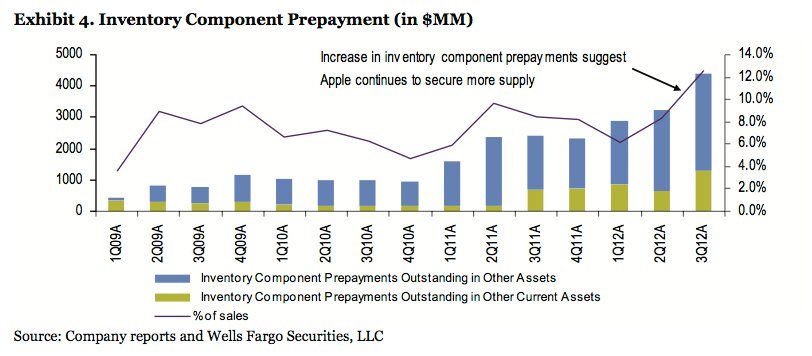September iPhone 5 release helps explain Apple’s weaker Q4 revenue and gross margin guidance

Yesterday, iMore broke the news that Apple would be holding a special event on September 12th, with a release of the iPhone 5 on September 21st. Most other major websites and news services have now reported on this too.
I think this new information really helps to explain the financial guidance that Apple provided to Wall Street on its conference call last week. In case you missed it, check out the summary I wrote about Apple’s Q3 results.
Here’s the short version: Apple told the Street that Q4 (September quarter) revenue will be down 4% sequentially (i.e. compared to the June quarter). But the kicker was gross margin guidance. Apple told analysts to expect only 38.5% gross margin compared to more than 42% in the most recent quarter. This resulted in a stock sell-off, with Apple shares declining by more than 5% in after-market trading on the night of the release.
I pointed out last week that Apple has sung this song before. Last year they guided down (on margin) for the September quarter only to come in significantly ahead of guidance. Apple is notorious for giving lowball guidance.
Gross margin effect of the new iPhone
Last year, we couldn’t blame the iPhone 4S launch on a margin hit to the September quarter. Why? Because it launched in October. The only hit to margins in the September quarter last year came from the back to school promos and volume reduction due to anticipation for a new iPhone launch in October. When companies sell less hardware, they lose some of their leverage. So margin goes down.
But this year? It’s now shaping up to be a totally different story. If Apple announces the new iPhone on September 12, and starts selling them on the 21st, then this new blockbuster product will have a massive effect on the current quarter. It may only be a few weeks of difference, but to Wall Street, it’s important because it dramatically affect the comparison to last year.
Wells Fargo analyst, Maynard Um, wrote about Apple’s huge prepayment for inventory in Q3. Buying inventory doesn’t affect gross margin in the period that you buy it. But it does affect margins when you sell that inventory in the form of finished goods (the shiny new iPhone 5). That’s because in accounting, you record costs associated to products at the time of sale, not at the time of inventory purchase.
Master your iPhone in minutes
iMore offers spot-on advice and guidance from our team of experts, with decades of Apple device experience to lean on. Learn more with iMore!

So when Apple starts shipping its new phone on September 21st, it will book revenue and record the cost of sales based on the cost of this new inventory. Because the iPhone 5 is expected to have LTE, a bigger and higher-tech screen, faster processor, and lots of other improvements, the components will cost more. Yet the price point (what Apple charges the carrier) may not change significantly. As a result, gross margin declines.
The timing of this year’s launch makes Apple’s guidance to Wall Street much more believable this year.
Will Apple regain its gross margin?
A lot of investors and analysts are wondering if Apple will regain its lost gross margin, assuming that they do report something in the high 30s for the September quarter. While the analyst community often obsesses over percentages, I think gross margin dollars are much more important. But before I get into that, let’s look at how margins are affected by product launches.
I already explained how new products can hurt margins because of more expensive components. But another factor to consider is the price reduction of older products. If Apple drops the price of the iPhone 4S by $100 (making it the new low-cost iPhone), this affects margin. And it’s a step change down, because Apple flips the switch on the price tag instantaneously.
How does the company recover from this? I’m not an expert in Apple’s supply chain practices, but I do know it’s quite common for OEMs to negotiate price reductions into supply agreements over the life of a product. I would guess Apple does this too. So whatever they pay for an iPhone 5 component in the September quarter might be higher than what they pay in December, March, and onwards. As long as Apple can hold onto its retail price while cutting the cost of its bill of materials, margin climbs.
Volume also matters, though. I’d argue that the iPhone 4S is a darn capable phone. At $99 on a contract, it will probably sell extremely well. We’ve seen this before. Most recently, when the new iPad launched, the iPad2 price was cut to $399. Apple acknowledged that this is hurting margins. But who cares? The iPad volumes are through the roof. Apple is spectacularly profiting from this move.
This brings me back to my original point about gross margin dollars versus percentage points. Would you rather see Apple sell 50 million iPhones at 38% margins, or sell only 40 million phones at 42% margin? Do the math. Shareholders make more money in the former scenario.
I’ll take the money, thanks.
Speaking of volume
While we’re talking about volume, it wouldn’t seem right to close off this article without mentioning Apple’s market share gains. Research firm Strategy Analytics reported some interesting numbers this week. According to their study, US smartphone sales actually declined by 5% in calendar Q2, compared to the prior year’s quarter. Shipments were 23.8 million instead of last year’s 25.2 million.
Here’s the bullish part for Apple: They were the only platform to show growth. Yup. Android volume declined 12%. BlackBerry volume declined 41%. But the mighty Apple? They expanded by a whopping 34%.
The total US smartphone market seems to be maturing, given the year over year decline in volume. But Apple still sits far behind Android in terms of market share, so it will be interesting to see how competitive Apple gets in order to make sure they don’t leave a “price umbrella” for competitors.
Perhaps a lower cost iPad mini is just the beginning?
Former sell side analyst, out-of-box thinker, consultant, entrepreneur. Interests: Wife & kids, tech, NLP, fitness, travel, investing, 4HWW.

